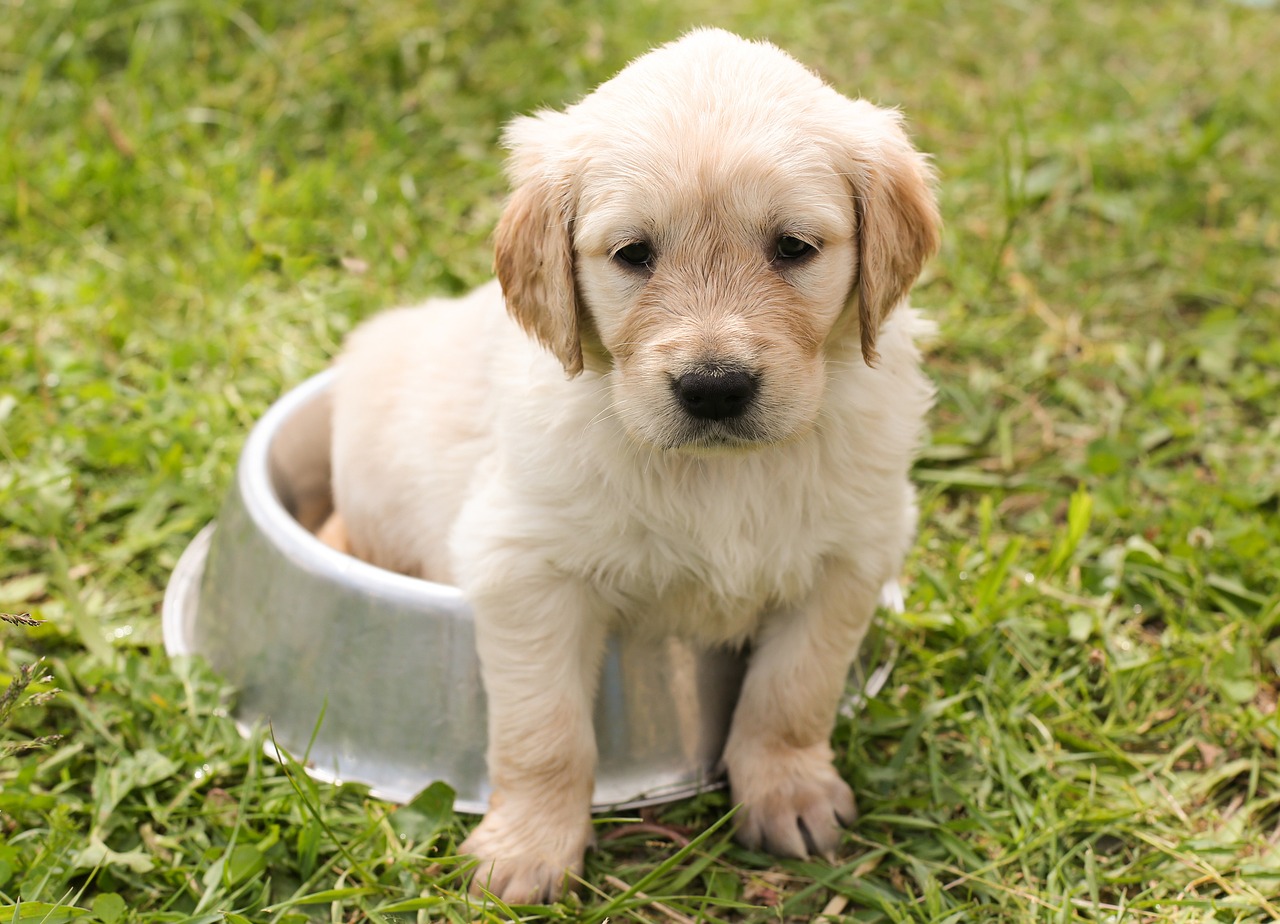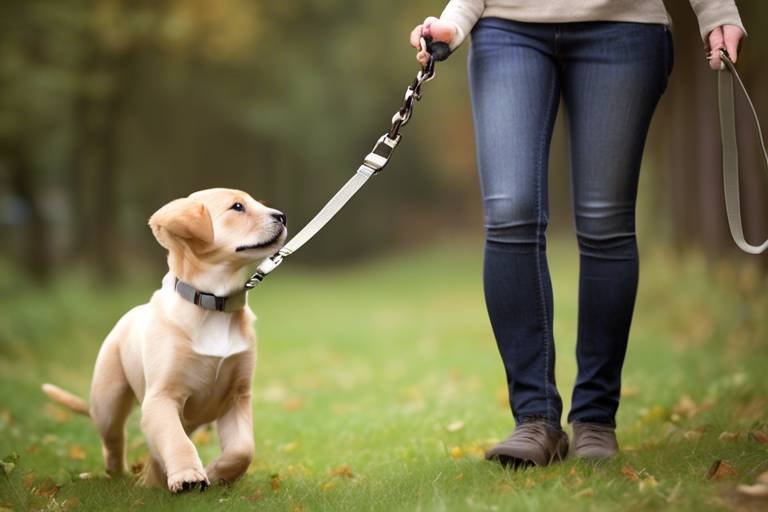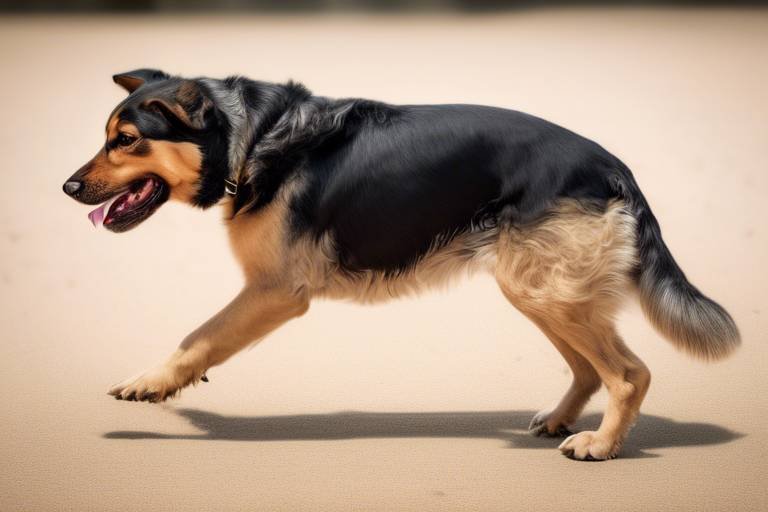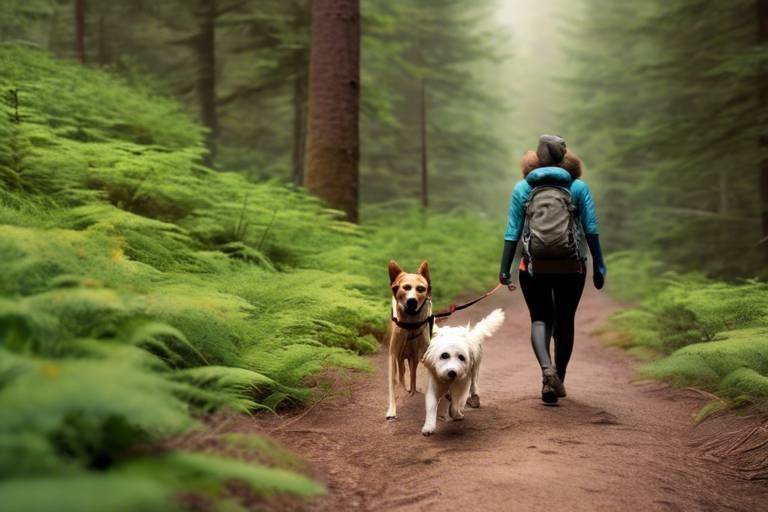Understanding Canine Fear Periods and Their Impact
Every dog owner knows that our furry friends can be quite the emotional beings. Just like humans, dogs experience a range of feelings, and sometimes they can feel a bit overwhelmed. One particularly intriguing aspect of canine behavior is the concept of fear periods. These are specific developmental stages that many dogs go through, marked by an increased sensitivity to their surroundings. Understanding these periods is not just a fun fact; it’s crucial for ensuring the emotional well-being of our beloved pets.
Think of fear periods as the teenage years for dogs. During this time, they might react to things that previously didn’t bother them, like the sound of a vacuum cleaner or the sight of a new person. It’s a time when their brains are developing, and they’re figuring out how to navigate the world around them. Just like a teenager might feel anxious about social situations, dogs can also feel heightened anxiety during these phases. Recognizing that these periods are natural can help owners respond with the right approach, turning potential challenges into opportunities for growth and bonding.
So, what exactly happens during these fear periods? Well, dogs may display a variety of behaviors that signal they’re feeling uneasy. This could range from simple signs of stress, like pacing or whining, to more pronounced reactions such as barking or even aggression. As a responsible pet owner, it’s vital to be aware of these signs, as they can help you intervene early and provide the support your dog needs. Ignoring these behaviors can lead to long-term anxiety issues, which nobody wants for their furry companion.
It’s also important to note that fear periods can occur at different ages and may vary from one dog to another. Some dogs may experience fear periods as puppies, while others might go through them later in life. This variability can make it tricky for owners to pinpoint when their dog is feeling fearful or anxious. However, by understanding the common characteristics of these periods, you can better prepare yourself to help your dog navigate through them.
In summary, recognizing and understanding canine fear periods is essential for every dog owner. It’s not just about managing behaviors; it’s about fostering a safe and supportive environment where our dogs can thrive. By being aware of the signs of fear and knowing how to respond, you can help your canine companion feel more secure during these challenging times. After all, a happy dog means a happy owner!
- What are the signs that my dog is experiencing a fear period? Look for signs such as trembling, hiding, barking, and avoidance behaviors.
- How long do fear periods last? Fear periods can vary in length, typically lasting a few weeks to several months, depending on the individual dog.
- Can I prevent fear periods in my dog? While you can't prevent them entirely, early socialization and positive experiences can help mitigate their impact.
- When should I seek professional help for my dog's fear issues? If your dog's fear seems overwhelming or leads to aggressive behavior, it's best to consult a professional trainer or a veterinarian.

What Are Canine Fear Periods?
Canine fear periods are fascinating yet challenging phases in a dog's development. During these specific stages, dogs experience heightened sensitivity to various stimuli, which can lead to increased anxiety and fear. Understanding these periods is crucial for pet owners who want to ensure their furry friends thrive emotionally and behaviorally. Just like humans go through phases of insecurity and self-doubt, dogs too navigate through their own unique fear periods, often characterized by a sudden and intense reaction to things they might have previously been indifferent to.
These fear periods typically occur at certain developmental milestones, often during puppyhood and adolescence. For instance, the first fear period usually happens between 8 to 11 weeks of age, while a second wave may occur around 6 to 14 months. During these times, a dog’s brain is rapidly developing, and their ability to process new experiences is still maturing. This means that a seemingly harmless event, like a loud noise or a sudden movement, can trigger an overwhelming fear response. It's as if their world is suddenly filled with monsters lurking behind every corner, making them wary and cautious.
As a pet owner, it's essential to recognize these periods and understand that they are a natural part of a dog's growth. During these times, dogs might exhibit various reactions, including:
- Increased sensitivity to sounds and sights
- Avoidance of previously enjoyed activities
- Changes in social behavior, such as reluctance to interact with other dogs or people
It's important to remember that while fear periods can be distressing for both the dog and the owner, they are typically temporary. With the right approach, you can help your canine companion navigate through these challenging times. This involves providing a safe and supportive environment, being patient, and using positive reinforcement to encourage them to face their fears gradually. Just as a child learns to overcome their fears with the support of a loving parent, your dog too can learn to feel secure and confident with your guidance.
In summary, canine fear periods are critical stages in a dog's emotional development that require understanding and compassion from their owners. Recognizing these periods and their characteristics can significantly impact how we manage our dogs' behavior, training, and overall well-being. By being proactive and supportive, we can help our furry friends emerge from these fear periods stronger and more resilient.

Signs of Fear in Dogs
Understanding the signs of fear in dogs is crucial for every pet owner. Just like humans, dogs express their emotions, but sometimes their feelings can be a bit more subtle. Recognizing these signs early can make a significant difference in how you respond to your furry friend during their times of distress. So, what should you look out for? Here are some common indicators that your dog might be feeling scared:
- Trembling: One of the most noticeable signs is trembling or shaking. This can occur even if the temperature is comfortable. It’s like when we feel anxious, and our hands start to shake.
- Hiding: Dogs often seek refuge in small, enclosed spaces when they’re scared. This behavior is their way of trying to feel safe, much like how we might curl up in a blanket when we’re feeling vulnerable.
- Barking: Excessive barking can also be a sign of fear. It’s their way of expressing discomfort or trying to alert you to something they perceive as a threat.
- Avoidance Behaviors: If your dog suddenly starts avoiding certain people, places, or situations they once enjoyed, it could be a sign of fear. This can manifest as backing away, turning their head, or even just refusing to engage.
These signs can vary in intensity and may not always be obvious. For instance, a dog may not tremble visibly but could be holding their body tensely, which is another subtle cue of fear. Additionally, some dogs may react by becoming overly aggressive as a defense mechanism. It’s essential to consider the context and your dog’s usual behavior to identify when something is off.
Moreover, during these fear periods, a dog's body language becomes incredibly important. Pay attention to their ears, tail, and overall posture. A dog that is scared might tuck their tail between their legs, flatten their ears against their head, or even avoid eye contact. These signals are their way of communicating that they are uncomfortable or frightened.
Recognizing these signs can lead to timely interventions, helping your dog feel more secure. If you notice any of these signs, it might be a good idea to create a calming environment for your dog, perhaps by providing a safe space where they can retreat. Remember, the goal is to make your dog feel safe and understood, just as we would want to be treated during our own moments of fear.
Q: How can I help my dog during a fear period?
A: Providing a safe and quiet space, using positive reinforcement, and gradually introducing them to the stimuli that frighten them can help. Patience is key!
Q: Are certain breeds more prone to fear than others?
A: Yes, some breeds may be more sensitive to fear stimuli due to their genetic predispositions. However, every dog is unique, and individual experiences play a significant role.
Q: When should I consult a professional?
A: If your dog's fear seems overwhelming or leads to aggressive behavior, it's best to consult a veterinarian or a professional dog trainer for guidance.
Behavioral Changes
During fear periods, dogs can undergo a variety of that can be quite alarming for their owners. Imagine your once playful pup suddenly turning into a shadow of their former self, avoiding interaction and retreating at the slightest sound. This shift isn't just a phase; it can significantly impact their overall behavior and emotional well-being. One common reaction is increased aggression, where a dog that typically displays friendly behavior may snap or growl when approached. This is often a defense mechanism, as they feel threatened and vulnerable.
Withdrawal is another significant behavioral change. Dogs may isolate themselves, seeking out quiet spaces to hide away from perceived threats. You might notice your furry friend curling up in a corner or refusing to engage in activities they once loved, such as playing fetch or going for walks. This withdrawal can lead to a cycle of fear, as the less they interact, the more anxious they become about the outside world.
Social interactions can also suffer during these periods. Dogs that were previously sociable may become hesitant or even fearful around other dogs and people. This change can be distressing not only for the dog but also for their owners, who may wonder what went wrong. To illustrate, consider a dog that used to thrive in a bustling dog park; during a fear period, they may freeze up or even try to escape the situation entirely. It's crucial for owners to recognize these signs early on to help their pets navigate these challenging times.
In essence, understanding these behavioral changes is vital for effective intervention. By being observant and recognizing the signs of fear, owners can tailor their approach to training and socialization, ensuring their dogs feel safe and supported. Remember, a dog's behavior during these periods is not a reflection of their true nature but rather a response to their environment and emotional state.
- What are the signs that my dog is going through a fear period?
Common signs include trembling, hiding, barking, and avoidance of certain situations or stimuli. - How long do fear periods last?
The duration can vary widely depending on the individual dog, but they typically occur during specific developmental stages. - Can I help my dog during a fear period?
Yes! Providing a safe environment, using positive reinforcement, and gradually exposing them to new experiences can help. - When should I consider seeking professional help?
If your dog's fear escalates to the point where it affects their daily life or safety, it's time to consult a veterinarian or a professional dog trainer.
Impact on Training
Training your dog can be one of the most rewarding experiences, but during fear periods, this process can become particularly challenging. Dogs in these sensitive stages may struggle to focus, making it difficult for them to learn new commands or behaviors. Imagine trying to have a conversation with a friend who’s distracted by a loud noise—it's tough, right? Just like that, your dog might be too preoccupied with their fears to pay attention to what you’re saying.
During these periods, you might notice that your dog becomes less responsive to commands they previously mastered. For instance, a dog that once eagerly sat on command might suddenly ignore you or appear hesitant. This behavior isn’t defiance; rather, it’s a natural response to their heightened anxiety. The emotional state of your dog can significantly impact their ability to learn, as fear can cloud their judgment and focus.
To navigate this tricky terrain, it’s essential to adjust your training methods. Here are a few effective strategies:
- Positive Reinforcement: Use treats, praise, or toys as rewards for any positive behavior. This approach helps build confidence and encourages your dog to engage despite their fears.
- Short Sessions: Keep training sessions brief to prevent overwhelming your dog. A 5-10 minute session can be much more effective than a longer one, especially when your dog is feeling anxious.
- Gradual Exposure: Introduce your dog to new commands or environments slowly. This gradual exposure can help them feel more secure and less anxious.
Moreover, it's crucial to remember that patience is key. Training during fear periods requires a gentle touch. If your dog is resistant or fearful, pushing them too hard can lead to further anxiety, which might create a vicious cycle of fear and avoidance. Instead, allow your dog to set the pace. Celebrate small victories, and don’t hesitate to take a step back if your dog seems overwhelmed.
In some cases, it might be beneficial to seek the help of a professional dog trainer or a behaviorist who specializes in fear-based issues. They can provide tailored strategies that consider your dog’s unique needs and help facilitate a more positive training experience. Remember, you’re not alone in this journey; many dog owners face similar challenges, and with the right approach, you can help your furry friend thrive even during their toughest times.
Socialization Challenges
Socializing your dog can feel a bit like navigating a minefield, especially during their fear periods. These are times when your furry friend may become extra sensitive to new experiences, sounds, and sights, making it challenging to introduce them to the world around them. Imagine taking a shy child to a bustling fair; the noise, the crowd, and the unfamiliar faces can be overwhelming! Similarly, your dog might react to new situations with fear or anxiety, hindering their ability to interact positively with other dogs and people.
During these periods, it’s not uncommon for dogs to show reluctance or even outright refusal to engage with new environments. They may cling to their owners or seek refuge in familiar spots, which can be disheartening for pet parents eager to help their pups become well-rounded companions. It's essential to recognize that pushing a dog too quickly into social situations can lead to negative experiences, reinforcing their fears rather than alleviating them. Instead, a more gradual approach is recommended, allowing your dog to acclimate at their own pace.
Here are some strategies to help overcome these socialization challenges:
- Start Slow: Begin with low-stress environments and gradually introduce your dog to new experiences.
- Positive Reinforcement: Use treats and praise to reward your dog for calm behavior in new situations.
- Controlled Exposure: Arrange playdates with other calm dogs or invite friends over to meet your dog in a familiar setting.
It's also vital to understand your dog's body language during these moments. Signs of stress, such as a tucked tail, flattened ears, or averted gaze, indicate that your dog might need a break. As a responsible owner, it’s your job to advocate for your pet's comfort and well-being. If your dog seems overwhelmed, don’t hesitate to step back and give them space. Remember, socialization should be a positive experience, not a source of stress.
Moreover, consider enrolling your dog in training classes that focus on socialization with a professional trainer. These environments are often designed to expose dogs to various stimuli in a controlled manner, allowing them to learn coping mechanisms while feeling safe. The key is to create a supportive atmosphere where your dog can thrive without the pressure of overwhelming experiences.
In summary, while socialization during fear periods presents unique challenges, it’s not insurmountable. With patience, understanding, and the right techniques, you can help your dog navigate their fears and emerge as a confident, social companion.
Q1: What are fear periods in dogs?
A1: Fear periods are specific developmental stages in a dog's life when they may exhibit heightened sensitivity to stimuli, making them more prone to fear and anxiety.
Q2: How can I tell if my dog is fearful?
A2: Signs of fear can include trembling, hiding, barking excessively, or showing avoidance behaviors. It's essential to recognize these signs early for effective intervention.
Q3: When should I seek professional help for my dog's fear?
A3: If your dog's fear seems overwhelming or is affecting their quality of life, it's advisable to consult a professional trainer or a veterinarian who specializes in animal behavior.
Q4: Can fear periods affect my dog's training?
A4: Yes, fear periods can hinder training progress, as dogs may become less responsive to commands or show reluctance to engage in learned behaviors during these times.
Q5: What are some common fear triggers for dogs?
A5: Common triggers include loud noises (like thunderstorms or fireworks), unfamiliar environments, and negative past experiences that can heighten anxiety during fear periods.
Managing Fear Periods
Managing fear periods in dogs is crucial for ensuring their emotional well-being and fostering a healthy relationship between pets and their owners. Just like humans, dogs can feel overwhelmed by their surroundings, especially during these sensitive phases. As responsible pet owners, we must create an environment that promotes safety and comfort. This starts with understanding that each dog is unique; what works for one may not work for another. Therefore, it is vital to observe your dog's individual reactions and adjust your approach accordingly.
One effective strategy is to create a safe space where your dog can retreat when feeling anxious. This could be a cozy corner of your living room, a crate with their favorite blanket, or even a designated room where they feel secure. Think of this space as a "doggy sanctuary" where they can escape the hustle and bustle of everyday life. It’s like having a personal retreat—who wouldn’t want that?
Another key element in managing fear periods is the use of positive reinforcement. Rewarding your dog for calm behavior during potentially frightening situations can help them associate these scenarios with positive outcomes. For example, if your dog remains calm during a thunderstorm, offering treats or praise can reinforce that behavior. It’s similar to how we learn; when we receive encouragement, we are more likely to repeat the behavior. Additionally, gradually exposing your dog to the stimuli that typically trigger their fear can help desensitize them over time. This process should be slow and controlled to avoid overwhelming your furry friend.
Furthermore, incorporating consistent routines can provide your dog with a sense of stability and predictability. Dogs thrive on routine, and knowing what to expect can significantly reduce anxiety. For instance, regular feeding times, daily walks, and play sessions can help your dog feel more secure. Just like humans, dogs appreciate a little structure in their lives!
Lastly, it's essential to remain calm and composed during your dog's fear periods. Dogs are incredibly intuitive and can pick up on their owner's emotions. If you react with anxiety or frustration, your dog may interpret this as a signal that there is something to be afraid of. Instead, approach these situations with patience and understanding, offering gentle reassurances. It’s like being a lighthouse in a storm—your calm presence can guide them safely through their fears.
In summary, managing canine fear periods requires a blend of creating a safe environment, employing positive reinforcement, maintaining consistent routines, and remaining calm. By taking these steps, you can help your dog navigate their fears and emerge stronger and more confident. Remember, patience is key—just like training for a marathon, it takes time and dedication to achieve lasting results.
- What are the common signs that my dog is experiencing a fear period? Look for signs like trembling, hiding, barking, or avoidance behaviors. These indicators can signal distress.
- How long do fear periods last? Fear periods can vary from dog to dog, often lasting from a few days to several weeks. It's essential to monitor your dog's behavior for any changes.
- Can I help my dog overcome their fears? Absolutely! With patience, positive reinforcement, and gradual exposure to triggers, you can help your dog build confidence and reduce their fears.
- When should I consider seeking professional help? If your dog's fear becomes overwhelming or leads to aggressive behavior, it's essential to consult a veterinarian or a professional dog trainer.

Common Fear Triggers
Understanding what can trigger fear in dogs is crucial for any pet owner. Dogs, much like humans, have their own set of fears and anxieties that can be provoked by various stimuli. These triggers can range from loud noises to unfamiliar environments, and recognizing them can help in preventing or mitigating fear responses. For instance, many dogs are particularly sensitive to loud noises, such as thunder, fireworks, or even the vacuum cleaner. These sounds can cause a dog to feel threatened, leading to trembling, hiding, or even aggressive behavior.
Another common trigger is unfamiliar environments. Just imagine being in a new place where everything feels foreign; the sights, sounds, and smells can be overwhelming. Dogs may react by becoming withdrawn or overly cautious. This is especially true for puppies who are still in their critical socialization phase. It’s important to remember that what seems like a mundane experience to us can be a source of anxiety for our furry friends.
Additionally, negative past experiences can leave a lasting impact on a dog’s behavior. If a dog has had a frightening encounter with a certain object, person, or animal, they may develop a fear of similar situations in the future. For example, a dog that was once startled by a loud clap of thunder may become fearful every time it rains. This learned behavior can be difficult to unlearn, which is why early intervention is key.
Here’s a quick overview of some common fear triggers:
- Loud noises (thunder, fireworks, sirens)
- Unfamiliar environments (new homes, parks, or even different rooms)
- Negative past experiences (a dog that was attacked by another dog)
- Changes in routine (moving house, new family members)
Moreover, environmental factors like sudden changes in the household, such as new furniture or the arrival of a new pet, can also contribute to a dog’s anxiety. Dogs thrive on routine and consistency; any disruption can lead to confusion and fear. It’s essential for owners to monitor their dog’s reactions to these changes and provide reassurance as needed.
In conclusion, being aware of these common fear triggers can empower dog owners to take proactive steps in managing their pets' fears. By recognizing and addressing these triggers, we can help our canine companions feel more secure and confident in their surroundings. After all, a happy dog is a well-adjusted dog!
- What should I do if my dog is afraid of loud noises? - Try to create a safe space for your dog, use calming music, or consult with a veterinarian for potential solutions.
- How can I help my dog adjust to new environments? - Gradually introduce your dog to new places and provide plenty of positive reinforcement.
- When should I seek professional help for my dog's fear? - If your dog's fear is severe and affecting their quality of life, it's best to consult a professional dog trainer or behaviorist.
Environmental Factors
Understanding is crucial when it comes to a dog's fear response. Dogs are incredibly sensitive to their surroundings, and even subtle changes can trigger anxiety or fear. For instance, consider how a thunderstorm can turn a calm pup into a quivering ball of nerves. The loud noises, flashing lights, and changes in atmospheric pressure can all contribute to a heightened state of fear. Similarly, moving to a new home or introducing new furniture can disrupt a dog's sense of security, making them feel vulnerable.
Moreover, the presence of unfamiliar people or animals in their environment can also lead to fear. Dogs are naturally territorial creatures, and any intrusion into their space can provoke a defensive reaction. This is especially true for dogs that have not been adequately socialized. If a dog has had negative experiences with certain types of people or animals, they may generalize that fear to all similar situations. For example, a dog that was once frightened by a loud man in a hat may become anxious around all men wearing hats, even if they mean no harm.
To illustrate how environmental factors affect a dog's behavior, consider the following table that outlines common environmental triggers and their potential impacts:
| Environmental Trigger | Potential Impact |
|---|---|
| Loud Noises (e.g., fireworks, thunder) | Increased anxiety, hiding, barking |
| New Environments (e.g., moving to a new house) | Withdrawal, reluctance to explore |
| Unfamiliar People or Animals | Aggression, fear-based reactions |
| Changes in Routine (e.g., new schedule) | Stress, confusion, behavioral issues |
Additionally, the physical environment plays a critical role in a dog's emotional state. For example, a cluttered or chaotic living space can overwhelm a dog, leading to stress and anxiety. Conversely, a calm and organized environment can help a dog feel more secure. To create a safe space for your furry friend, consider the following tips:
- Establish a designated area for your dog with their bed and toys.
- Minimize loud noises by using soundproofing materials or white noise machines.
- Maintain a consistent routine to provide stability.
- Introduce new experiences gradually to prevent overwhelming your dog.
In summary, environmental factors significantly influence a dog's fear response. By recognizing and addressing these triggers, owners can help their dogs navigate through fear periods more effectively. It's all about creating a supportive environment that fosters confidence and security, allowing our canine companions to thrive.
Q: What are some signs that my dog is experiencing fear due to environmental factors?
A: Common signs include trembling, hiding, barking excessively, or showing signs of aggression. Pay attention to any changes in behavior, as these can indicate fear.
Q: How can I help my dog cope with fear triggered by environmental changes?
A: Gradual exposure to new environments, positive reinforcement, and creating a safe space at home can help your dog feel more secure and confident.
Q: When should I seek professional help for my dog's fear issues?
A: If your dog's fear is overwhelming or leads to aggressive behavior, it may be time to consult a professional trainer or a veterinarian specializing in animal behavior.
Owner Reactions
As a dog owner, your reactions during your pet's fear periods can significantly influence their emotional state. Imagine your furry friend trembling at the sound of fireworks. How you respond in that moment can either help them feel safe or amplify their anxiety. It's like being a lighthouse in a storm; your calm presence can guide them through the rough waters of fear. When you notice signs of distress, such as cowering or barking, it's crucial to maintain a calm demeanor. If you panic or show signs of anxiety, your dog may interpret that as a signal that something is indeed wrong, which can heighten their fear even further.
One effective way to reassure your dog is through positive reinforcement. When they encounter something that frightens them and you respond with soothing words or treats, you help them associate that fear-triggering experience with something positive. For instance, if your dog is scared of a vacuum cleaner, calmly praising them while they are near it, or giving them a treat can help them gradually overcome their fear. However, it’s essential to avoid overwhelming them; instead, take baby steps, allowing them to adjust at their own pace.
Additionally, it's important to recognize that every dog is unique. Some may require more time and patience than others. You might even consider keeping a journal to track your dog's reactions and your responses. This can help you identify patterns and adjust your approach accordingly. For example, if you notice that your dog is particularly fearful of loud noises, you could create a safe space in your home, equipped with their favorite toys and blankets, where they can retreat during stressful situations.
Moreover, don’t forget the power of body language. Dogs are incredibly perceptive and can read our emotions through our posture and facial expressions. If you’re tense or stressed, they’ll pick up on that energy. Instead, try to embody a relaxed posture, speak in a gentle tone, and offer reassuring touches. This can go a long way in helping your dog feel secure. Remember, your goal is to be their anchor, providing them with the confidence to face their fears.
In some cases, if you find that your reactions aren't helping or if your dog's fear seems to worsen, it might be time to seek professional help. Dog trainers or behaviorists can provide tailored strategies to help both you and your dog navigate these challenging periods. They can offer insights that you might not have considered, helping to create a more harmonious environment for both of you.
- What are the signs that my dog is fearful? Look for signs such as trembling, hiding, barking excessively, or avoiding certain situations.
- How can I help my dog during a fear period? Remain calm, use positive reinforcement, and create a safe space for them.
- When should I seek professional help for my dog's fear? If your dog's fear seems overwhelming or if their behavior changes significantly, it may be time to consult a professional.

When to Seek Professional Help
Recognizing when your furry friend is struggling with fear can be challenging. While it’s normal for dogs to experience occasional anxiety, there are specific situations where seeking professional help becomes essential. If your dog’s fear escalates to the point where it interferes with their daily life, it’s time to consider reaching out to a veterinarian or a certified animal behaviorist.
One key sign that your dog may need professional assistance is if their fear leads to aggressive behavior. This could manifest as barking, growling, or snapping, particularly when they feel cornered or threatened. Aggression can not only put other pets and people at risk but can also severely affect your dog’s quality of life. If you notice these behaviors, it's crucial to consult a professional who can help you navigate this complex issue.
Another situation that warrants professional intervention is if your dog exhibits extreme anxiety that persists over time. For example, if your dog is trembling, hiding, or refusing to eat for extended periods, these are red flags that should not be ignored. A professional can help determine if there are underlying medical conditions contributing to the fear or if behavioral therapy is needed to address the anxiety.
Additionally, if your dog experiences fear during routine activities, such as going for walks or visiting the vet, this could indicate a more profound issue that needs expert attention. A professional can guide you in developing a tailored plan to help your dog cope with these fears, making daily life more manageable for both of you.
In some cases, medication may also be recommended to help alleviate your dog’s anxiety. This is particularly true if their fear is severe and unmanageable through behavioral modification alone. A veterinarian can provide insight into the safest and most effective medications to support your dog's emotional health.
Ultimately, the goal is to ensure that your dog leads a happy and fulfilling life. If you ever feel unsure about your dog’s behavior or emotional state, don’t hesitate to seek help. Remember, early intervention can make a significant difference in your dog’s ability to cope with fear and anxiety.
- What are the signs that my dog needs professional help? Look for signs of aggression, prolonged anxiety, or fear that interferes with daily activities.
- Can fear periods be managed at home? Yes, but in severe cases, professional guidance is recommended for effective management.
- What types of professionals can help with my dog's fear? Veterinarians and certified animal behaviorists are excellent resources for addressing canine fear issues.
- Is medication necessary for all fearful dogs? Not always; medication is typically reserved for severe cases where behavioral modifications are insufficient.
Frequently Asked Questions
- What are canine fear periods?
Canine fear periods are specific developmental stages in a dog's life when they become extra sensitive to various stimuli. These periods can significantly affect their behavior, making it crucial for dog owners to understand and manage these phases effectively.
- How can I recognize signs of fear in my dog?
Common signs of fear in dogs include trembling, hiding, barking excessively, and avoiding certain situations or people. If you notice any of these behaviors, it might indicate that your dog is experiencing fear, especially during a fear period.
- What behavioral changes should I expect during fear periods?
During fear periods, dogs may show increased aggression, withdrawal from social interactions, or changes in their usual behaviors. This can affect their relationships with both humans and other animals, so it's essential to monitor these changes closely.
- How do fear periods impact dog training?
Fear periods can hinder training progress as dogs may become less responsive to commands or reluctant to engage in previously learned behaviors. Adjusting training methods to accommodate your dog's emotional state is vital during these times.
- What are the best ways to manage my dog's fear periods?
To manage fear periods effectively, create a safe environment for your dog, use positive reinforcement techniques, and gradually expose them to stimuli in a controlled manner. This approach helps build their confidence and reduces anxiety.
- What common triggers should I be aware of?
Common triggers for fear in dogs include loud noises (like thunderstorms or fireworks), unfamiliar environments, and negative past experiences. Being aware of these triggers can help you prevent fear-related issues.
- How do environmental factors influence my dog's fear response?
Changes in a dog's surroundings, such as moving to a new home or introducing new pets, can significantly affect their fear response. Understanding these factors can help you mitigate any anxiety your dog may experience.
- How should I react when my dog shows fear?
Your reaction to your dog's fear can greatly influence how they cope. Staying calm and providing reassurance is key. Avoid showing anxiety yourself, as it may exacerbate your dog's fearful behavior.
- When should I seek professional help for my dog's fear?
If your dog's fear becomes overwhelming or interferes with their daily life, it may be time to seek professional help. A trained behaviorist or veterinarian can provide guidance and support to ensure your dog's emotional well-being.



















